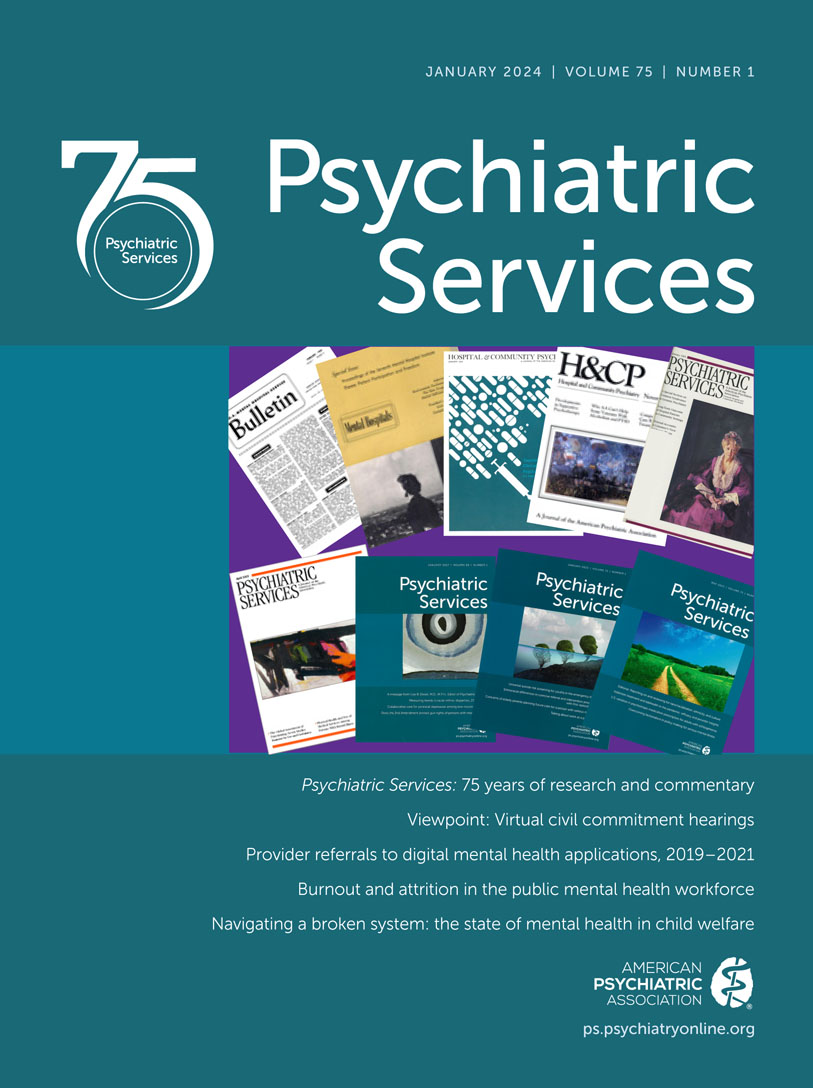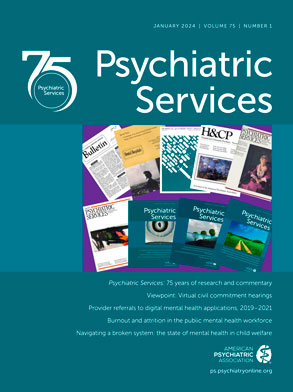Involuntary civil commitment (CC) is a legal intervention in which a person experiencing symptoms of a serious mental illness (e.g., a mental illness that causes serious impairment) is court ordered to receive supervised inpatient care. Although CC laws vary by state, many of them share common features. For patients to be involuntarily hospitalized, most CC laws specify that they must present a danger to the life or safety of themselves or others. Every patient has the right to a formal hearing in which a hearing official considers all evidence and testimony and may order release from care unless specified criteria have been met.
To limit COVID-19 exposures, many courts rapidly adapted CC hearings from an in-person to a virtual (videoconferencing) format. The virtual format allows the patient to be in one location (often at the hospital) and the hearing official (often a judge) to be in another location; the patient’s attorney may also attend from another location. Many courts are opting to continue to conduct fully virtual hearings in the aftermath of the COVID-19 pandemic, and this decision raises important questions: How should CC hearings be conducted now that in-person gatherings present less of an imminent threat to personal health and safety? Do virtual hearings present any obstacles for officials as they weigh all the evidence to make a fair determination of whether the patient meets legal requirements to be retained in hospital care?
Although prior publications have discussed the ethics of virtual CC hearings (
1–
3), we argue that this literature presents a one-sided view and highlights the convenience of virtual hearings for legal officials and counselors (
1–
3). What is needed is a thorough ethical analysis of the benefits versus costs (or risks or challenges) of virtual CC hearings. In this Viewpoint, we contend that virtual hearings may present challenges to making fair and accurate safety determinations and may contribute to both overuse and underuse of CC. In the final section, we discuss the fact that our opinions are largely influenced by our own (local) experiences and how this local lens may limit generalizability of our claims to medical systems and courts in other geographic regions.
Challenge 1: Potential for Exclusion of Important Information
Several features of videoconferencing technologies may impose challenges to making fair and accurate safety determinations. For instance, muting patients (i.e., turning off their microphone) may prevent them from providing vital information that can help to explain their perspective or behavior and may also prevent the hearing officials from witnessing statements or behaviors that either affirm or refute safety risk. In a 2008 Montana CC case, a patient (L.K.) appealed her commitment order. She argued that her rights were violated when the judge ordered staff to mute her microphone on numerous occasions (
4,
5). Even though the Supreme Court of Montana upheld the original decision on appeal and ruled that the use of the microphone by the district court was appropriate (
5), this case highlights the concern that the muting feature may be used to inappropriately prevent patients from providing important testimony relevant to their case, thus leading to inappropriate (i.e., overuse of) commitment.
Reduced audiovisual data in virtual hearings may also lead to ill-informed safety determinations and underutilization of commitment. In an in-person hearing, a patient’s speech and behavior cannot be censored: the patient’s voice cannot be muted, and the patient cannot be hidden from view by shutting off a computer camera or altering its angle. In virtual CC hearings, onsite staff may intentionally angle the camera away from and mute the patient to reduce disruptions. This action contradicts the central goal of the CC hearing—to obtain an accurate representation of the patient’s behavior and perspective in order to make fair and accurate safety determinations. Consider a case in which a patient has repeated, paranoid outbursts that interrupt the hearing. For convenience, onsite staff may intentionally mute and angle the camera away from the patient, thereby limiting officials’ direct observation of the patient’s symptoms, behavior, and intentions to harm themselves or others. This hypothetical case highlights the risk for underutilization of commitment (e.g., signs that the patient needs continued inpatient care and monitoring are hidden from the official, who releases the patient from care).
We acknowledge that the factors that bear on these outcomes may vary at the local level. First, it matters who is present onsite with the patient. For instance, in a fully remote hearing, the patient’s attorney may be offsite, and thus only designated hospital staff would be capable of changing the camera angle. An additional consideration that may affect the hearing’s outcome is who has authority to mute the patient. At our hearings, the hearing official (judge) serves as host and is the only person granted authority to mute the patient. In rare instances, the judge may mute the patient after several failed attempts to limit disruptions (e.g., typically after several verbal requests have been made to the patient to remain quiet during certain proceedings not requiring the patient’s testimony). The patient’s attorney may occasionally request that the hearing official mute the patient, but our hospital staff never make requests to mute patients. Despite local variability in these factors, we conclude that virtual CC hearings may lead to cases of ill-informed safety decisions, resulting in the risk for both overuse and underuse of commitment.
Challenge 2: The Digital Divide and Patients With Serious Mental Illness
Evidence is growing that people with serious mental illness have reduced literacy regarding Internet-based digital technologies (
6,
7). This digital divide may raise concerns about conducting virtual CC hearings for patients with serious mental illness. The virtual format may make it difficult for patients to perceive social or nonverbal cues of court officials. This difficulty may hinder patients’ understanding of what is going on during the hearing and may also provoke stress and frustration, which could manifest in outbursts. This behavior could be interpreted by officials at the hearing as cause for safety concerns, when in fact the behavior may have simply been triggered by additional obstacles or stressors being placed before the patient (e.g., having to make sense of interactions, instructions, expectations, and etiquette on a virtual platform that may be prone to glitches). This hypothetical case highlights another example in which virtual CC hearings may lead to overutilization of commitment.
Finally, patients with less experience and comfort in operating technology may be disadvantaged in communicating with their legal counselor during the prehearing meeting as well as with officials during the hearing. For patients, the virtual format could make understanding the hearing process and their rights difficult; for hearing officials, this format may hinder the perception of patients’ verbal and nonverbal cues, which inform the determination of whether they present a danger to the life or safety of themselves or others. In summary, the virtual format introduces additional communication barriers that may interfere with accurate assessments and decision making.
Conclusions and Looking Forward
We have adopted a clinical perspective centered on the values and well-being of patients during CC proceedings, drawing attention to the possibility that virtual hearings may present challenges for making fair and accurate safety assessments. Our Viewpoint is novel because prior literature has predominantly focused on the purported benefits of virtual hearings, such as mitigation of some safety risks accompanying in-person hearings (e.g., COVID-19 transmission or patient elopement) and convenience for judges and legal counselors (
1–
3). A sound ethical analysis of whether fully virtual CC hearings should be the gold standard ought to weigh the potential benefits of virtual hearings against potential concerns and challenges, including those described in this Viewpoint. When balancing the needs and values of different stakeholders in the CC process, the convenience for legal officials should not carry undue weight; the values, needs, and rights of patients and other stakeholders must also be considered. Drawing from our personal experiences, we conclude that CC courts should consider adapting at least some aspects of hearings to an in-person format (e.g., prehearing consultations with legal counselors or having at least one official present with the patient), because face-to-face communication is of paramount importance to achieving effective communication between patients with serious mental illness and counselors and court officials.
We acknowledge that multiple factors limit the generalizability of our conclusions. First, we decided to focus on the general procedures of inpatient CC hearings. Given the narrow scope of our discussion, we caution against the direct application of our conclusions to other related cases that may involve hearings for individuals with diminished mental capacities (and potential loss of rights and freedoms), such as conservatorship hearings. Second, our argument stems from our clinical perspectives, but it has both ethical (fairness) and legal (due process) implications. However, a thorough discussion of these implications is beyond the scope of this Viewpoint.
We recognize that our opinions are influenced by our unique experiences and observations at inpatient psychiatric units of the University of Maryland Medical System. Experiences may vary across hospitals and courts in different geographic regions and may influence the process of weighing factors in an ethical cost-benefit analysis. For instance, before the COVID-19 pandemic, we were conducting CC hearings at the hospital. Although safety risks tied to patient elopement did not serve as a major consideration in our cost-benefit analysis, such risks could be a key consideration in geographic regions that require patient transport to the courtroom for CC hearings.
Although our goal was to highlight the challenges and concerns that virtual hearings introduce, additional benefits of virtual CC hearings beyond those discussed in the current literature may also be present. For instance, virtual hearings may allow for reduced delays, which would benefit patients (e.g., shorter delays between the patient’s hospital admission and scheduled hearing, shorter delays in receipt of needed treatment, or reduction in or avoidance of prolonged hospitalizations). In our experience, however, we have seen a marked increase in hearing delays since the switch to virtual hearings. We speculate that this increase is due to the increased conveniences (e.g., schedule flexibility, effective time management, and low cost) for hearing officials and attorneys associated with postponement requests. In the past, we held in-person hearings at the hospital on Mondays; postponement was rare because everyone was onsite and committed to the process. Unfortunately, our facility’s CC hearings are still scheduled on the basis of the rigid prepandemic calendar and have not evolved in parallel with the shift to a virtual format. This inflexibility means that delays yield burdens that are shouldered by the hospital and the patient: the hospital must continue to offer treatment and patients must wait (often against their will) in administrative and clinical limbo for another week.
Given the heterogeneity of experiences across hospitals and districts and the need to confirm whether there are concerns regarding making fair and accurate safety assessments, we advise gathering feedback from various stakeholders in the CC process about their experiences, including feedback from involuntarily admitted patients about their experiences with virtual technologies. This feedback will not only provide fresh perspectives on key challenges but also help to ensure that the highest standards of fairness, accuracy, and integrity are maintained in the CC process.
Acknowledgments
The authors thank Howard H. Goldman, M.D., Ph.D., for reviewing drafts of the manuscript and providing helpful feedback.

